We put this Alaska road trip guide from what we learned by driving to Alaska the entire way, both north and south. Below is what worked well for us (and what didn’t) – to make your drive to Alaska even better than ours.
Are you looking for the ultimate road trip? The journey to Alaska from the lower 48 States is most travelers’ top road trips. It is one of our favorite road trips to date!
Before hitting the road, make sure to pick up the most up-to-date Alaska Milepost book here.
First of all, the drive to Alaska is much easier than most travelers expect. When most people envision the drive to Alaska and driving in Alaska, they start to turn into doomsday preppers.
Often people think driving the Alaska Highway will be all winter driving with crazy icy road conditions the entire journey. WRONG!
Most travelers think they’ll need three spare tires and gas cans strapped to every flat surface of their vehicle. Driving in Alaska isn’t nearly what you think, and the entire Alaska Highway is better than you think.
You do need to prepare when you drive north to Alaska, but not like this. We’ll explain – while giving you all of the Alaska by car tips, the best routes to Alaska, the best scenic stops along the Alaska Highway, and itinerary advice for the Alaska drive for this epic adventure!
We get several comments & emails every week asking what to pack when driving to Alaska. Here is our list of must-have items on Amazon.
You should really start with a copy of the Milepost Alaska travel planner. It will help you get detailed information to plan your trip, and it’s even better to have it in the car when driving—because there is not going to be cell service, let alone internet, for most of the drive to Alaska and along the Alaska Highway.
Click Here To Buy The Milepost 2024 Edition
2024 Milepost – Best Alaska Map for an Alaska Road Trip
Can You Drive to Alaska in 2024
Yes, you can drive from the US to Alaska in 2024. There are NO COVID-19 requirements for entry into Canada. You can now cross the Canadian border from the States like before COVID-19 ever happened.
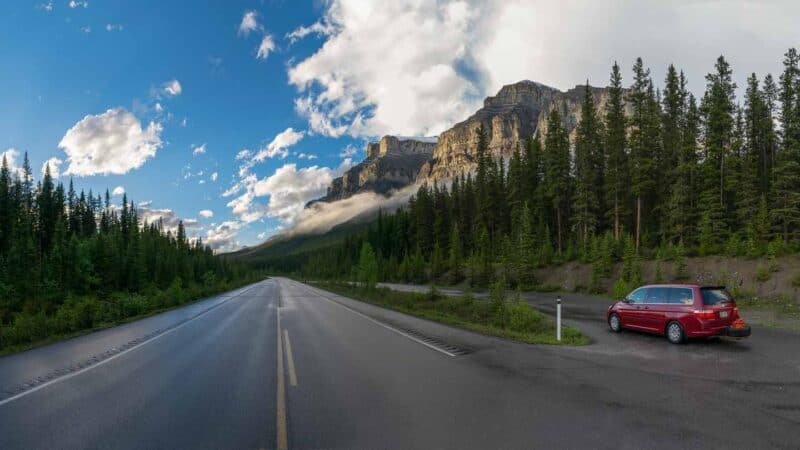
Best Guidebook for Driving to Alaska
The best or only real guidebook is the Milepost book. If you are making the journey, you should probably have one of these. We recommend picking one of these up well in advance of your trip to help plan.
The #1 thing to buy for a trip to Alaska, it helps plan & you’ll need it in the car when driving!
It takes some time to get used to the layout, but once you do, it will have more info than you’ll ever need on all the Alaskan roads & Alaska Highway and the route to Alaska through Canada. You can order the Milepost book online here.
Cell Phone service and Best Carriers for a road trip to Alaska?
Cell coverage on the ride up to Alaska was better than expected for the most part but still a lot worse than the roads. Once you are north of Calgary, expect very little service along the Alaska Highway except in the small towns. While traveling through small towns, you will almost always have cell service, and most will also have data too.
Best Satellite Communicator To Have
If you’re driving by yourself or have a loved one driving to Alaska alone and you want some extra piece of mind, you should consider packing a satellite communicator. A satellite communicator can send messages, emails, and emergency SOS messages. For less than $200, it wouldn’t be a bad idea to have it.
In Canada – Many U.S. carriers extend their plans into Canada at no extra cost. We found T-Mobile shared towers with many Canadian carriers and worked better than our Verizon line for both calls and data. It’s best to contact your carrier to see how your plan will work in Canada before switching it on across the border.
In Alaska – Cell and data coverage are overall better than in Canada, but it is the U.S., so many carriers will switch to roaming, which is limited on most plans. There is better coverage between towns in Alaska than in northern Canada, but mostly for calls, the internet is still limited to the towns and cities. AT&T and Verizon, according to locals, are the best for coverage in Alaska. We had a Verizon line, and it worked all right, but it was still pretty limited.
Our T-Mobile line picked up GCI a majority of the time. We were told by T-Mobile we only got 200MB of roaming data included in our plan, but it never shut us down. We called to inquire how much data we had used in Alaska, and they said 0 MB. So, we were able to use our T-Mobile with no problems the entire time. GCI has prepaid options from $20+, depending on how much data you need. GCI is Alaska’s largest wireless network and fastest 4G network.
Related Article: Things To Do In Homer Alaska
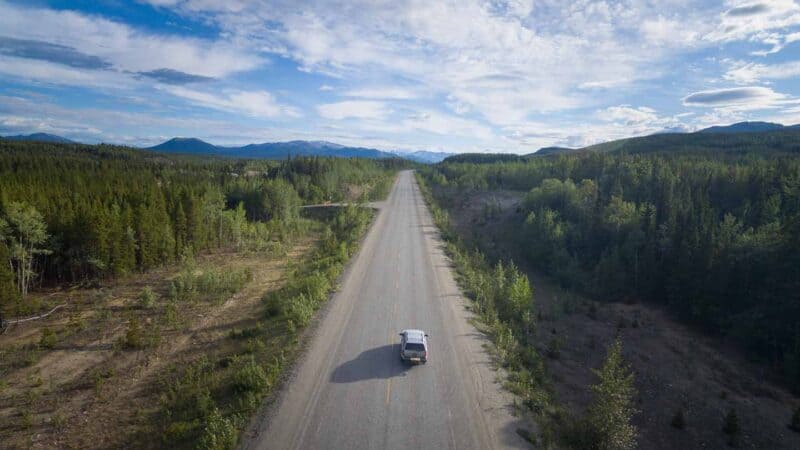
Best Vehicle to Drive to Alaska?
ANY vehicle is capable of making the drive to Alaska in the summer months. You don’t need a 4×4 or anything crazy. We’ve seen motorcycles, full-size RVs, trucks with a 5th-wheel camper, and even our basic grocery-getting minivan was fine on the Alaska Highway.
If those giant RVs pulling cars can make it on the roads, so can your car. Our 11-year-old DIY campervan made the drive to Alaska without issue. Click here to watch our YouTube video and see what our van looks like.
It’s a good idea to make sure your vehicle is in good mechanical order because from anywhere in the lower 48 of the U.S., a drive to Alaska is at least 48 hours of drive time.
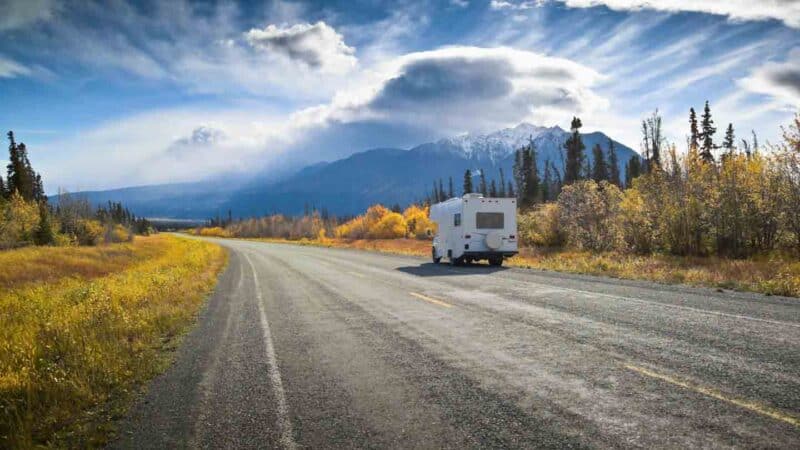
Driving to Alaska FAQ
Q.) Is driving to Alaska worth it?
A.) Yes, driving to Alaska is absolutely worth it! I am positive anyone who has made the drive will agree. There’s nothing quite like it, and you get to see so much along the way.
Q.) Is it safe to drive the Alaska Highway?
A.) Yes, driving to Alaska is generally safe, and so is the Alaska Highway. There are normal road hazards, but with normal, careful driving and some planning, you should have a safe trip. If you do run into trouble, people along the highway tend to help each other out.
Q.) Can you drive to Alaska without going through Canada?
A.) No, you can not drive all the way to Alaska without going through Canada. However, with the use of the Alaska Marine Highway system, you can take your vehicle to Alaska without going through Canada – just a short 97 hours on the ferry.
Q:) Can you drive to Alaska during the winter months?
A:) Yes, the Alaska Highway is open year-round. See more below about driving to Alaska during the winter.
Q.) Can I drive through Canada to Alaska without a passport?
A.) No, you need your passport. It’s required to cross the Canadian border into Canada and back into the United States when you read Alaska.
Q.) Can you drive to Juneau, Alaska?
A.) No, you can not drive to Juneau without the use of ferries. There are no routes to Alaska that enter Juneau by car without taking the ferry. If you want to bring your car, you will have to take the car ferry to Alaska.
Q:) What month is best to see the Northern Lights in Alaska?
A:) Between August and April is your best chance of seeing the Northern Lights in Alaska. If you are driving the Alaska Highway driving back to the States, plan to spend a few days in Fairbanks. Fairbanks is one of the best places in Alaska to see the Northern Lights.
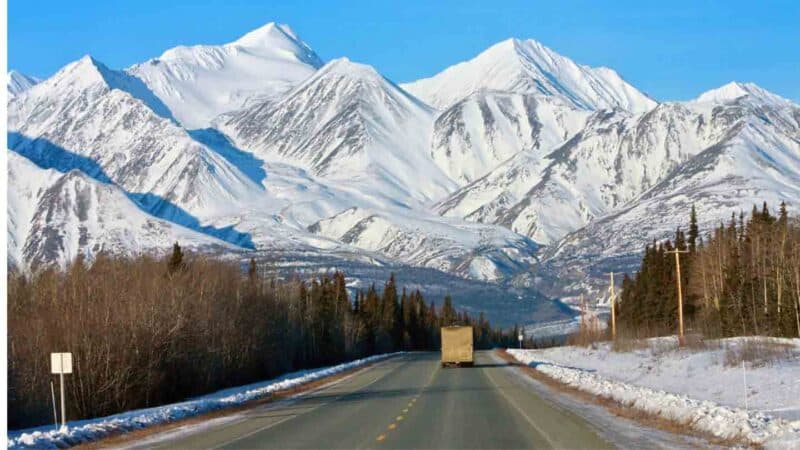
How are the Roads to Alaska on the Alcan Highway in 2024?
In the middle of the Summer of 2022, there was a section of the Alaska Highway / Alcan highway that was washed out just south of the British Columbia and Yukon Border—apparently caused by a beaver dam that gave way (yes, really) and flooding. There has since been a 3 km detour created to reopen the flow of traffic. It is unclear at this time when this portion of the Alaskan Highway will be fully repaired.
In most years, the condition of the roads will depend on how tough the winter is and how much it heaves the roads. Overall, on our last trip, the roads were far better than we expected while planning an Alaska road trip.
For the vast majority of the drive to Alaska, the road is a two-lane asphalt paved highway with a gravel shoulder large enough for a standard vehicle. There are passing lanes periodically, but the traffic is very thin, and passing is generally not an issue.
When is the Best Time to Drive to Alaska?
The best time to drive the Alaska Highway is from May to September. During the summer months, the road conditions on the Alaska Highway will be at their best.
During the summer, there are more hours of daylight, the best driving conditions, and more services are open along the Alaska Highway. Several places close during the winter months, as very few travelers make the journey during the winter.
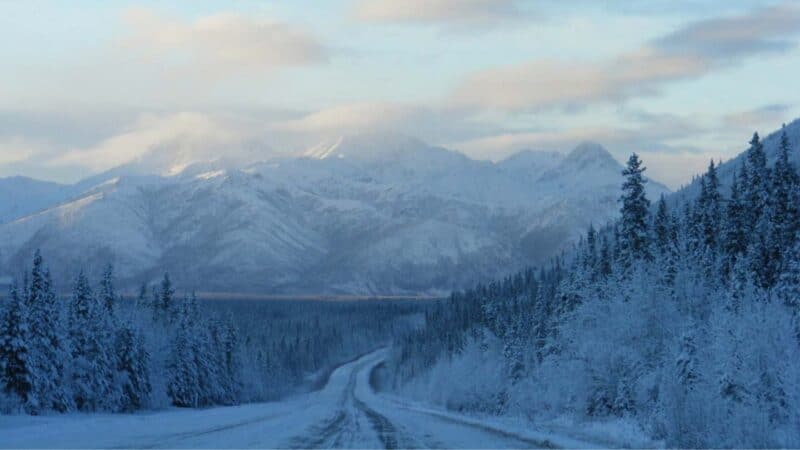
Driving The Alaska Highway in Winter
The road is less traveled due to shorter hours of daylight and winter driving conditions. Be prepared for icy road conditions and snow-covered roads. Don’t rush. Give yourself plenty of time when driving to Alaska during the winter.
If you are up for this adventure, make sure you are prepared and have a backup plan! Always have extra gas with you. Gas stations along the Alaska Highway in the winter have very limited hours. Expect extreme cold temperatures. Make sure you have the appropriate cold-weather clothing and gear in your car.
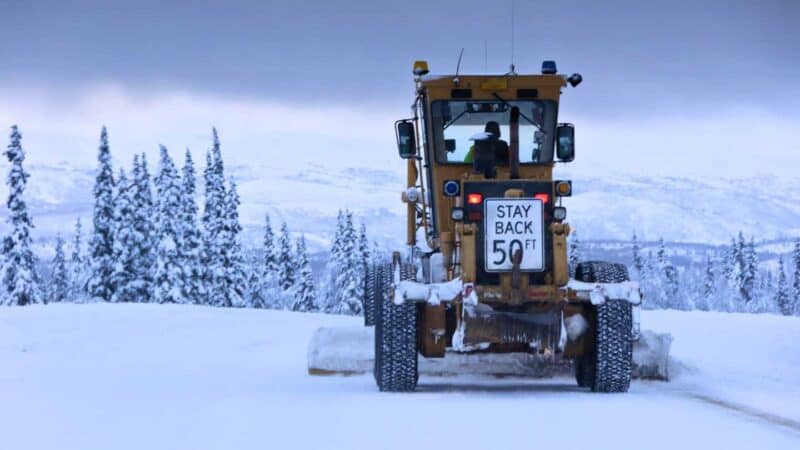
The road conditions and driving will be worse in the Yukon and the interior parts of Alaska in the winter. The chances of seeing wildlife along the Alaskan Highway are much less.
*Note that winter tires are required when driving in British Columbia from October 1 to March 31.
Can you Drive from Seattle to Alaska?
Yes, you can drive from Seattle to Alaska. There are two route options. Both of the routes below have you driving from Seattle to Prince George, British Columbia, along the Trans-Canada Highway. Once you are in Prince George, you will have two routes to choose from.
Most travelers cross the Canadian border at the Sumas-Huntingdon border crossing, which is just north of Seattle and is open 24 hours a day.
You can either take Highway 97, which will connect with the Alaska Highway in Dawson Creek, or we suggest driving the Cassiar Highway.
The Cassiar Highway is technically shorter in distance than the Highway 97 route, but it is the longer route from Seattle. It is 100 miles shorter, but the Cassiar Highway is more remote and the more scenic route, in our opinion. It is less traveled, only a two-lane road, has a lower speed limit, and offers a better chance of seeing wildlife. The Cassiar Highway joins the Alaska Highway by Watson Lake in the Yukon Territory.
If you decide driving Highway 97 from Seattle is your preferred route, you will drive the entire Alaska Highway starting at Mile 0, which starts in Dawson Creek. Highway 97 is the fastest route in regard to time and has more restaurants, hotels, gas stations, etc., along the route, but it is 100 miles longer.
Both Highway 97 and Cassiar Highway are scenic drives through British Columbia with high chances of seeing some wildlife along the way. You could drive to Alaska from Seattle via Highway 97 and then drive Alaska to Seattle on the Cassiar Highway. That way, you can experience each route.
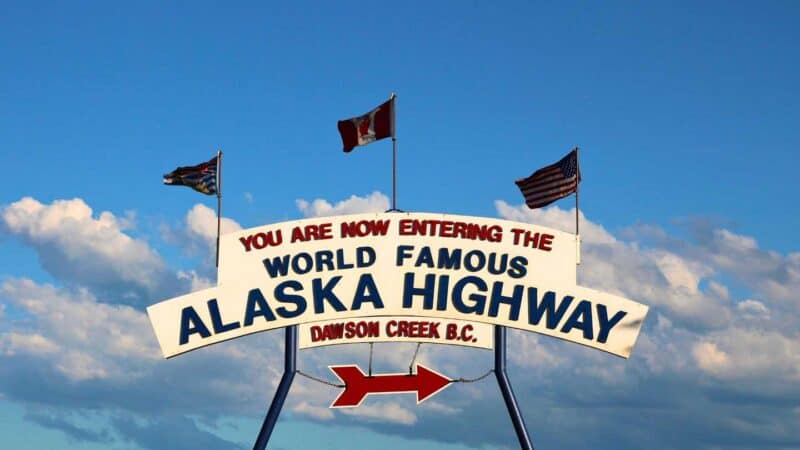
Quick Alaska Highway Facts
The Alaska Highway is 1,382 miles/2,224 km long and starts in Dawson Creek, British Columbia, and ends in Delta Junction, Alaska.
The highway is open year-round. The road, for the most part, is paved the entire length of the highway. You will run into patches of construction along the route.
It once was 1,422 miles long, but after some rerouting and construction, the highway in Alaska is now 40 miles shorter. You may notice this if you pay attention to the mile markers. Alaska has yet to change its mile markers to the new length. You may notice this when you cross the Alaska-Yukon border.
The Alaska Highway is also known as the Alcan Highway. It got the name Alcan by shortening Alaska and Canada.
The Alaska Highway ends in Delta Junction, Alaska. Many travelers think it ends in Fairbanks, but that is incorrect. The Delta Junction to the Richardson Highway, which goes to Fairbanks.
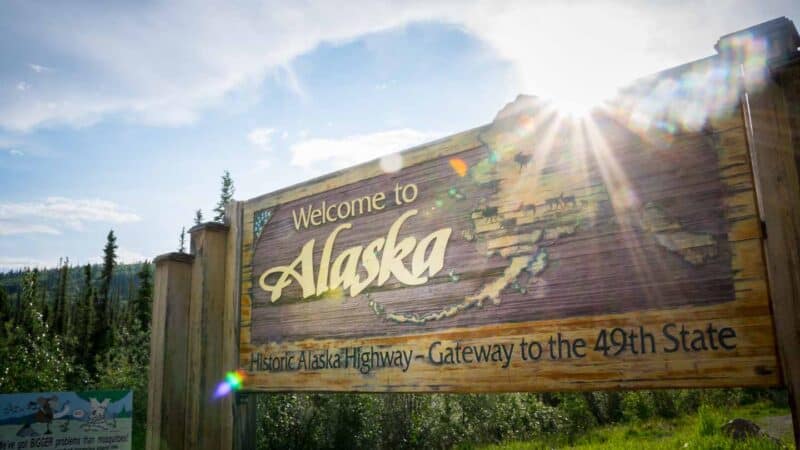
How Much Time Do I Need in Alaska?
Alaska is a massive state, and how much you will see will depend on how much time you have. We would suggest you spend about two weeks in Alaska at minimum (more is better) to see most of the drivable highlights of the state. A longer trip is better than a short trip.
If you don’t have a month to drive to Alaska, you should probably fly to Alaska and make an Alaska road trip instead. Most Alaska road trips start from Fairbanks or Anchorage, as they have the best flight options. Whether you are flying to Alaska from California, New York, or Wisconsin, like us, there are daily flights to Alaska. We would suggest flying into Anchorage and renting a car to start your journey.
While there are many amazing things to see on the way to Alaska, you don’t want to have to get all the way there to turn around. There are several amazing National Parks in Alaska and Canada, tons of wildlife, including moose & bears, often right along the Alaska Highway, and you can’t forget the gorgeous Canadian Rockies.
Renting a Car in Alaska
If you want to explore Alaska by land but don’t have time to drive the whole way, you can rent a car in Alaska or rent an RV.
Car rental prices in Alaska are NOT CHEAP. I am talking $150+ a day.
There is such a short season, and rental cars in Anchorage and Fairbanks airports are in high demand. Once you know your travel dates and are planning your adventure, book your rental car now. We book online here.
Most rental cars come with unlimited miles (but double-check your terms). If you have time, see if you can explore Canada and Alaska. That way, you could make a mini adventure to the Yukon as well.
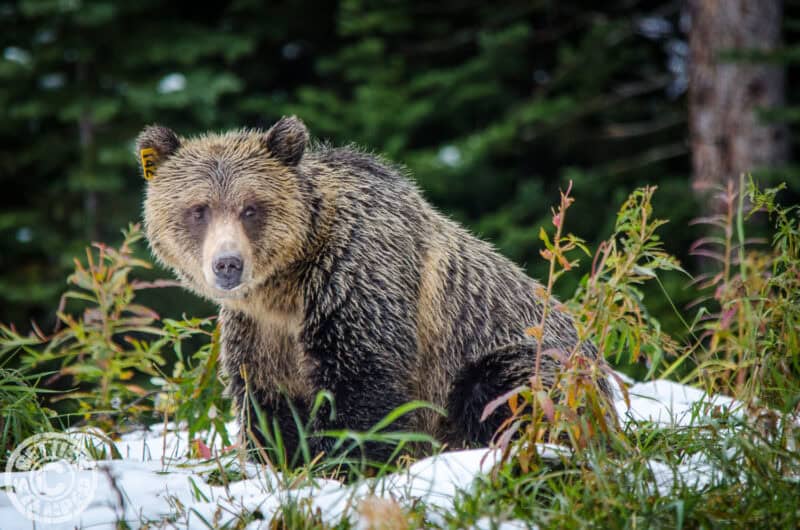
Wildlife along the Alaska Highway
We saw sooo many moose and bears just off the road. There become a point where we stopped pulling over to take photos or just watch the wildlife.
The best time to see moose in Alaska is September and October during their breeding season.
The best time to see bears in Alaska is from July through September. We saw more bears along the highway in the Yukon. You most likely will not see a bear in Alaska if you are on an Alaska road trips.
We shouldn’t have to say this, but keep your distance. Do not get out of your car and approach wildlife!
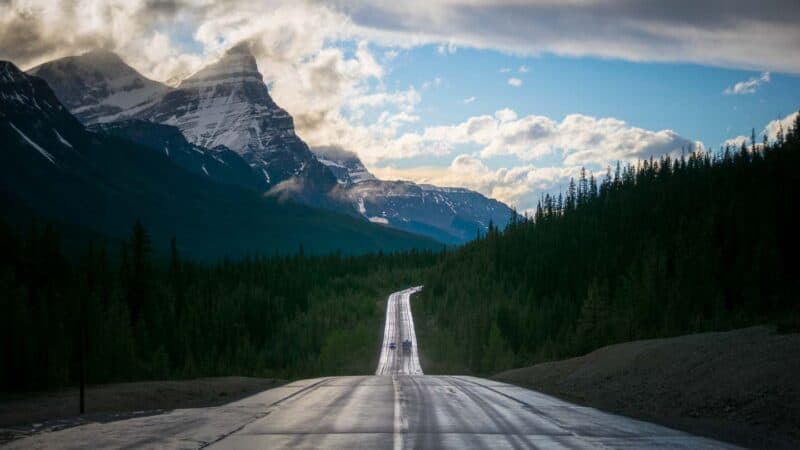
How Much Time Do I Need to Drive to Alaska?
Keep in mind while planning you are going to need at least a week to drive up and another week to drive home from Alaska. It can be done quicker, but then you are going to miss some of the greatest sights in North America and the Rockies.
Two weeks of drive time will allow you to make some stops and actually enjoy the journey – again, if you don’t, you might as well fly to Alaska. See our Alaskan road trip guide and itinerary for everything to see while in Alaska.
Actual drive times will depend on where your trip starts. The time is really dictated by what you want to see along the way. Do you want to drive right through the Yukon, or do you want to see some sights? We suggest one week to drive safely to Alaska without too many stops.
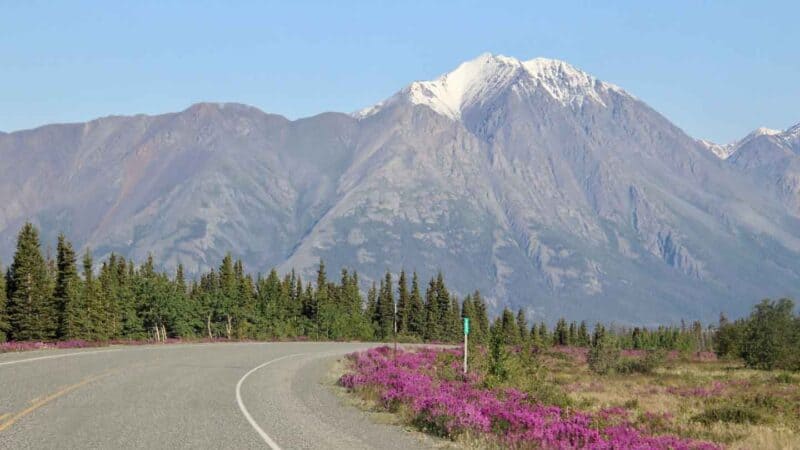
The Best Route to Drive to Alaska and Road Trip Itinerary
If your goal is to get to Alaska the fastest way possible, you’re better off flying to Anchorage and renting a car in Alaska. As they say, it’s not the destination; it’s the journey.
There are lots of AMAZING things to see on the way to Alaska, and you should make time to see them along the way. You might want to take one route there and another back, possibly going back through Seattle one way. We wish we had had time to drive the Cassiar Highway and make the drive from Alaska to Seattle.
From the eastern half of the United States, most map programs will have you travel through North Dakota into Canada to Edmonton and then finally join the Alcan Highway in Dawson Creek. Take this route if you like loooooooong stretches of flat, boring land. However, if you add just 9 hours of driving to your route, you can see some of the most fascinating landscapes in North America.
Here are our perfect routes to Alaska. No matter which part of the country you are coming from, it would be a road trip sin not to stop in the Canadian Rockies. Make time in your itinerary on either the way to Alaska or on the journey home. No matter which route you take, you’ll be going through the Yukon Territory and British Columbia and jumping on the Alaska Highway near Dawson Creek.
Since everyone is coming from somewhere different, this addresses the Canadian and Northern US portions of the route only. You should allow a minimum of four weeks for this route, and 5-6 weeks would be more comfortable. For the Alaska portion of the suggested itinerary, see our Alaska Road Trip itinerary and guide.
Related Article: One of Alaska’s Best Kept Secrets – Hatcher Pass
Essential Stops on the Drive to Alaska:
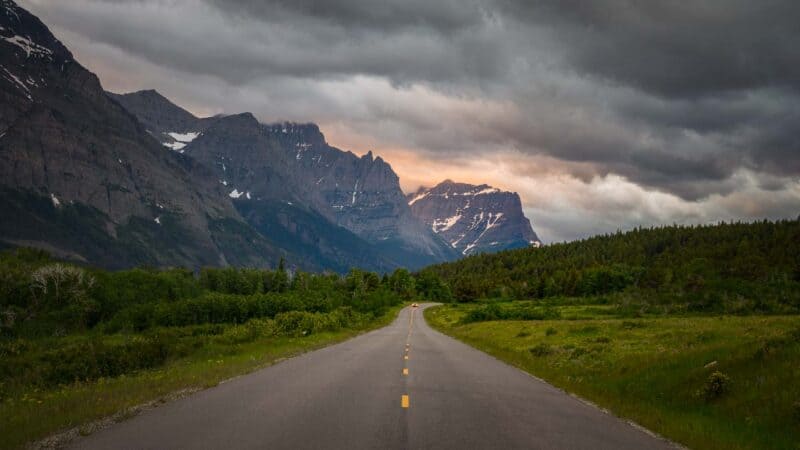
Glacier National Park – Montana, USA
If you are in a hurry, you can cover most of the driving highlights of this park in a single day. However, if you have time, we suggest about three days to properly see Glacier National Park. It is one of our favorite National Parks in the United States.
The high mountains can cause weather issues (even in early summer). Extra time would allow a better chance to see this stunning park under blue skies.
If you’re short on time, at least drive the Going to the Sun Road that crosses the park. If you have more time, take in a sunset at our favorite spot, Two Medicines Park Road, or hike the Avalanche Trail.
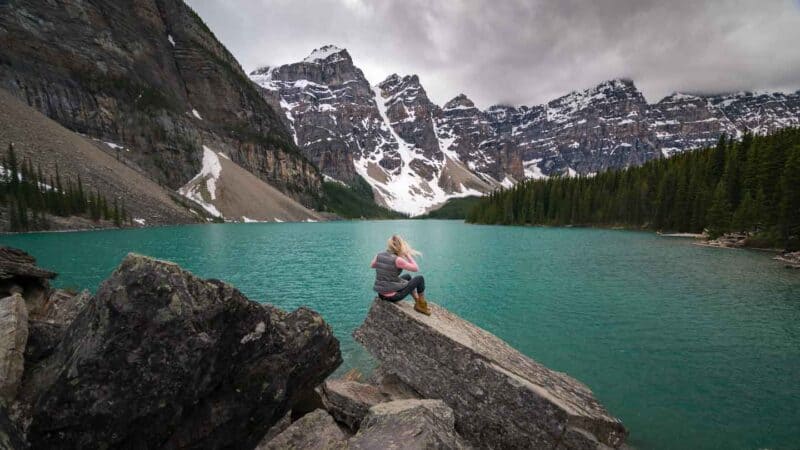
Banff National Park – Alberta, Canada
One of the most picturesque places on the continent, Banff, should really be part of your trip. A trip to British Colombia requires a few days in Banff National Park. Even those in a hurry should plan three days to take in the sights between Banff, Jasper, and the Icefields Parkway.
Places not to miss while in Banff are Moraine Lake, Lake Louise, Peyto Lake, and Bow Lake.
If you have more time, three days in Banff will cover the major highlights. If you’re really short on time, you can jump on a Banff helicopter tour and see the park from a whole other level. Banff is a well-known ski area, but year-round, there’s so much to see and do in Banff.
Related Article: Things to do in Banff
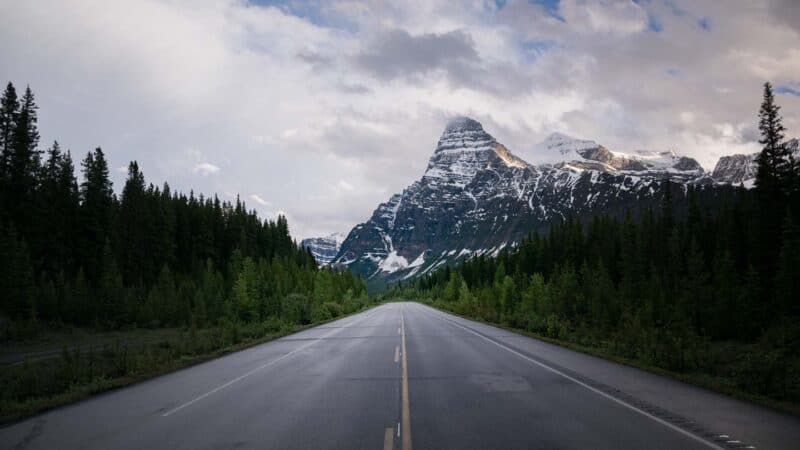
Icefields Parkway – Alberta, Canada
Another must visit in British Columbia is driving the Icefields Parkway. It is one of the most scenic drives you’ll ever take. While only 144 miles (232km), you could drive it in just over 2 hours.
There are literally hundreds of stops along the way. This drive deserves at least a day of your road trip to Alaska. Two days would allow you to walk on the Columbia Icefield and really see this amazing place properly.
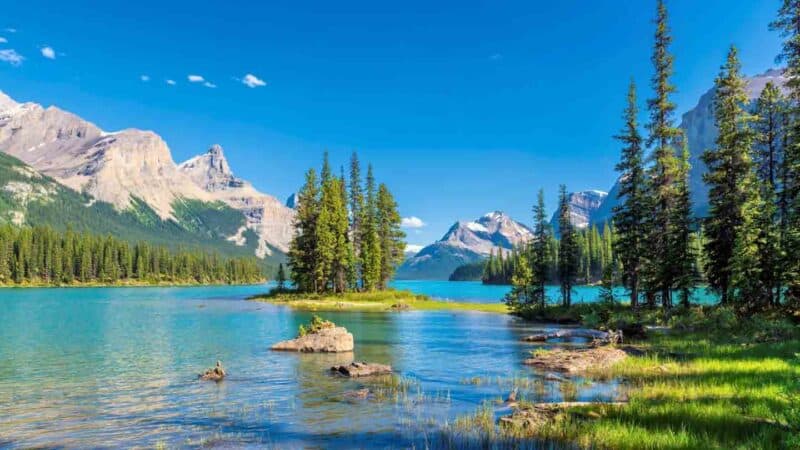
Jasper National Park – Alberta, Canada
At the top of the Icefields Parkway is another impressive Canadian Park. Jasper National Park is full of more impressive mountains and glacial feed lakes and rivers. Some of the national park highlights not to miss are the Valley of 5 Lakes hike and the massive Pyramid Mountain. Plan at least a day inside Jasper, and three days would allow you to cover most of the highlights.
From Jasper, make your way up HWY 40 in Alberta to connect with the Alcan Highway in Dawson Creek, where the Alaskan Highway starts. From the Alcan Highway, there are fewer possible deviations since this is the main route.
Good Stops: Muncho Lake Provincial Park, Stone Mountain Provincial Park, Destruction Bay, Tetlin Junction, Skagway. From Jake’s Corner in the Yukon, you can make your way down to Skagway & Haines, Alaska.
For the Alaska portion of the suggested itinerary, see our Alaska Road Trip itinerary and guide.
What to pack to drive to Alaska
While it’s good to be prepared for the very long drive to Alaska, but after doing it – there’s a more reasonable approach. Here, we will go over some of the things we packed that worked well and some that didn’t.
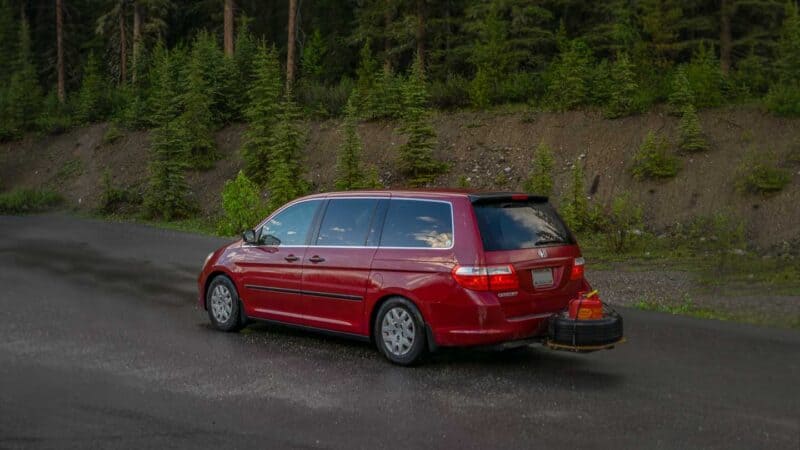
Do I Need a Full-Size Spare Tire when Driving to Alaska?
Having a full-size spare would help you to make you more independent and better prepared for any issues. However, the roads to Alaska are, in general, in pretty good shape.
If a flat tire occurs, a small donut tire would likely get you to the next town that could repair it. This would slow down your trip, but you’re not going to be eaten by bears if you don’t have a full-size spare.
To answer the question better, we spent a few hundred dollars and two days adding a spare tire to a vehicle that was not made to carry one. In hindsight, it was not worth it. However, if you can easily add a full-size spare tire to your vehicle, do it. Call a junkyard and get a rim and a used tire, and you’ll be ready if something does happen.
Do I need extra jerry cans of gas to drive to Alaska?
The simple answer is no. There is no stretch of road anywhere on the route to Alaska that is longer than 200 miles without a gas station. However, you’ll see all kinds of vehicles with multiple gas cans strapped to the back (we did too).
Overall, we found it unnecessary to carry extra gas. However, it was a peace of mind while in what felt like the middle of nowhere. The main exception is if you plan on driving longer, more remote stretches of the road to Alaska at night or early in the morning.
Many of the gas stations along the route to Alaska (especially in Canada) are old-school, without card readers, meaning the stations have to be open to get gas. Our minivan campervan gets around 400 miles to the tank, and we just never let it get too far under 1/2 a tank and never had an issue.
If you plan on going to more remote areas off of the main highways in Alaska and northern Canada, you still will want an extra gas can. We really liked the nice sturdy metal gas can we brought for this trip, which actually fit inside of our full-sized spare that was on a carry-in our hitch receiver.
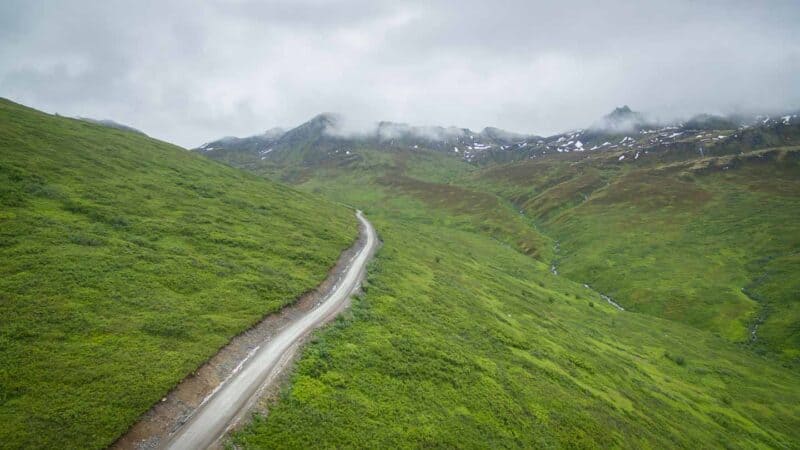
Random things you should know before driving the Alcan or Alaska Highway:
- In British Columbia, if you are caught going more than 40 kph over the speed limit, they will impound your car for seven days. Watch your speed when driving! We found this out when we got stopped going around 30 kph over. The trooper let us off with a warning because he was on his way to a missing person. Lucky for us, not so much them. However, he made it seem like his hands would be tied if caught over 40 kph.
- Canada restricts certain types of weapons from being brought into the country, including pepper spray. This makes carrying bear spray into Canada a little bit of a gray area. According to most sources, it is now legal if it’s bigger than 9oz, and the label states USDA repellent registration. Also on the restricted list are handguns and military-like assault weapons. If declared, you can bring in rifles and shotguns for hunting. You must register at the border and pay a fee. See a more comprehensive list and regulations on the RCMP official website.
How Much Does it Cost to Drive to Alaska?
Calculating the cost of a road trip to Alaska will depend on your route, gas mileage/price, driving habits, road conditions, lodging, and food along the way. Everyone’s trip will be different, but here are a few tips on how to budget your Alaska drive trip.
- Use a map tool to calculate how many miles your trip will be. Take that number and add in some miles for sightseeing and then double it for driving home.
- If you know your vehicle’s gas mileage, you can easily figure out the gas cost.
- Plan out your route, where you would like to stop along the way, and the type of accommodations you want. Will you be camping or staying in hotels along the way to Alaska? This will be one of your biggest budget factors.
- Make sure to factor in a budget for food. It could be as little as $10 per day per person if you’re cooking your own meals or much higher if eating primarily in restaurants. There are not a ton of restaurants in the Yukon or along the Alaska Highway except in the larger cities.
- Lastly, make sure to leave some money for seeing the sights – entrance fees, park passes, etc.
Are you planning to drive to Alaska? Or have you already done the drive? Share your questions and tips in the comments!
Don’t forget to pin me for later!
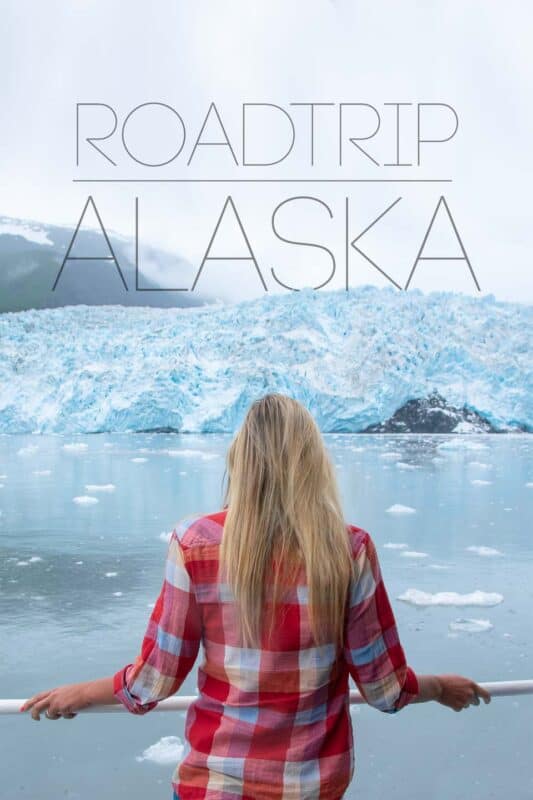
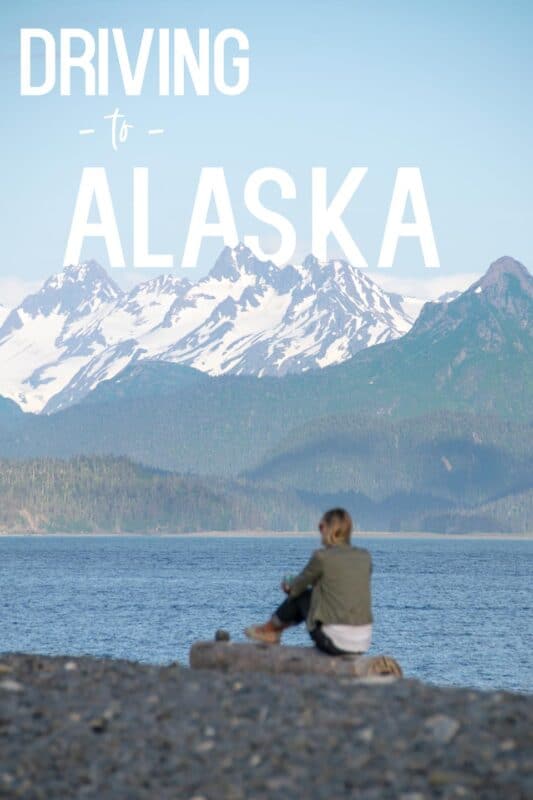
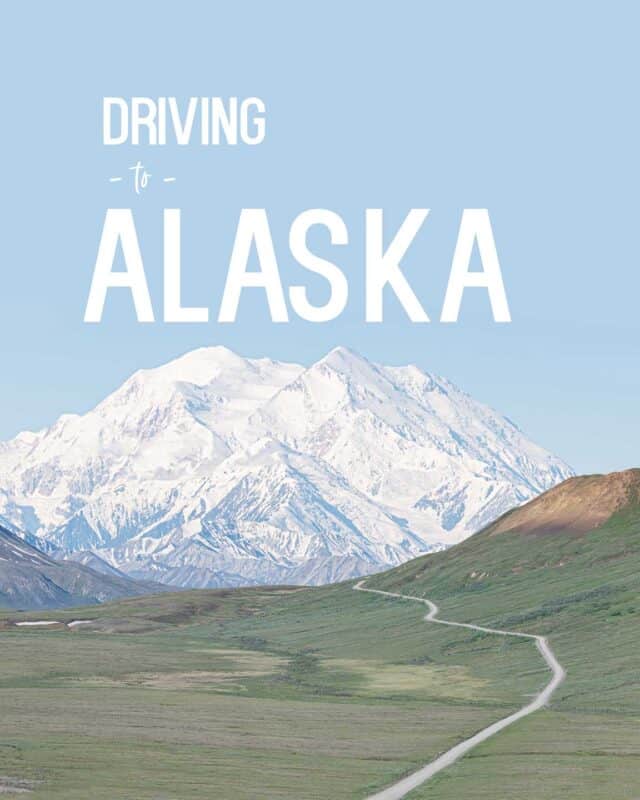
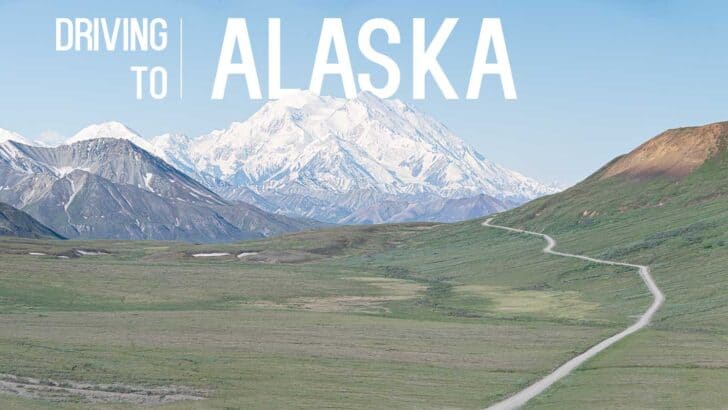
Sherrie seward
Saturday 1st of July 2023
Thank you for so much informative information.
Bob Crane
Sunday 13th of March 2022
Thanks for posting this! My wife and I are getting ready to drive to AK from Central Wisconsin this summer in our Sienna mini van. Planning for about 10 weeks, lots of things to see and do.
John Fouse
Monday 28th of June 2021
The Alaska Hwy is all paved now. So, the drive is much easier than it used to be. The Canadian border officials can be a real pain. But, you just have to put up with it. DO NOT have a temper flare up! If you do they'll just deny you entry and turn you around. DO NOT try to sneek a hand gun into Canada. If they search your vehicle and they find it you're in big trouble. They really don't like any kind of gun.
Make sure you've got good tires. If you need to buy tires they will charge an arm and a leg. Same for batteries. There are plenty of places to stay, buy gas/diesel and food. No need to carry gas cans.
Summer time is a good time to drive. Winter can be bad because of the cold. There are places where it can get down to -50F or -60F. It can get colder than that.
If your vehicle takes premium gas when you get into Alaska the highest octane you can buy is 90. And it's lousy. You'll get less power and worst mileage. Buy octane booster before you leave home or in the states.
Also, make sure you've to all the paperwork for your vehicle. Insurance, and registration. They might ask you for it at the border. You'll also need a passport to get into Canada.
The border is still closed as of today, Monday June 28th 2021. No telling when they'll reopen it.
The people here (Alaska) are very friendly. Alaska is more than 2.5 times bigger than Texas.
Diane Huffman
Tuesday 13th of April 2021
Awesome and informative post! I worked in Denali YEARS ago ('99,00, and '01) and did that drive back and forth each summer from Utah and Colorado. It's interesting to hear that there are still gas stations that don't have pay-at-the-pump. I remember sleeping at the gas station waiting for it to open because I needed more gas to continue. It is an incredible drive, I'd love to do it again some time when COVID restrictions end.
John LeMaster
Thursday 8th of October 2020
My wife and I drove from Washington to Alaska and back with our travel trailer about 10 years ago. We really enjoyed our trip and would like to do it again. However, we are concerned that it may not be the same because of over crowding and heavy traffic during the summer months. If that's the case we may want to remember it the way it was. That's true of so many places we used to enjoy visiting, but now avoid because they are totally jammed with cars and people making everything a real hassle. What have conditions been like the past couple of summers?
Adam
Thursday 11th of February 2021
I don't think 'heavy traffic' applies with a drive to Alaska yet. On our last drive, I think there were days when we saw less than a dozen cars all day.